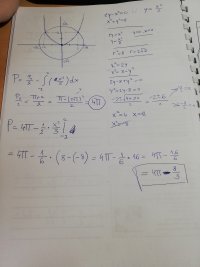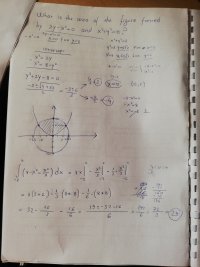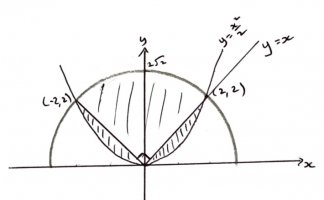You are using an out of date browser. It may not display this or other websites correctly.
You should upgrade or use an alternative browser.
You should upgrade or use an alternative browser.
Area of a figure
- Thread starter Loki123
- Start date
The area you are looking for is the area of the semi-circle with a radius of 2 minus the area of the area below a parabola. It should be obvious that the answer will include pi.
The area of the semicircle is [imath]0.5 * \pi * 2^2 = 2 \pi.[/imath]
The area of the parabola is [imath]\int_{-2}^2 0.5x^2 \ dx.[/imath]
EDIT: Your problem, as skeeter already pointed out, is that the equation of the line bounding the relevant semicircle is
[math]y^2 + x^2 = 8 \implies y^2 = 8 - x^2 \implies y = \sqrt{8 - x^2}.[/math]
So you. can use calculus with respect to both curves, but you do not need to. Realizing that the area of the semicircle is [imath]2 \pi[/imath] would have told you right off the bat that your answer was wrong.
The area of the semicircle is [imath]0.5 * \pi * 2^2 = 2 \pi.[/imath]
The area of the parabola is [imath]\int_{-2}^2 0.5x^2 \ dx.[/imath]
EDIT: Your problem, as skeeter already pointed out, is that the equation of the line bounding the relevant semicircle is
[math]y^2 + x^2 = 8 \implies y^2 = 8 - x^2 \implies y = \sqrt{8 - x^2}.[/math]
So you. can use calculus with respect to both curves, but you do not need to. Realizing that the area of the semicircle is [imath]2 \pi[/imath] would have told you right off the bat that your answer was wrong.
Last edited:
Why the radius of 2??The area you are looking for is the area of the semi-circle with a radius of 2 minus the area of the area below a parabola. It should be obvious that the answer will include pi.
The area of the semicircle is [imath]0.5 * \pi * 2^2 = 2 \pi.[/imath]
The area of the parabola is [imath]\int_{-2}^2 0.5x^2 \ dx.[/imath]
EDIT: Your problem, as skeeter already pointed out, is that the equation of the line bounding the relevant semicircle is
[math]y^2 + x^2 = 8 \implies y^2 = 8 - x^2 \implies y = \sqrt{8 - x^2}.[/math]
So you. can use calculus with respect to both curves, but you do not need to. Realizing that the area of the semicircle is [imath]2 \pi[/imath] would have told you right off the bat that your answer was wrong.
skeeter
Elite Member
- Joined
- Dec 15, 2005
- Messages
- 3,204
I'm sure [math]r = 2\sqrt{2}[/math] is what Jeff meantWhy the radius of 2??
Skeeter is kind. I just had a mental lapse and thought 4 instead of 8. My point was that it was obvious that [imath]\pi[/imath] would be in the answer and that (assuming you were paying attention as I was not), you do not need calculus to determine the area of a semicircle.
Yes, Steven, I am on my way to the corner for [imath]\sqrt{2}[/imath] minutes.
Yes, Steven, I am on my way to the corner for [imath]\sqrt{2}[/imath] minutes.
I got 4Pi -16/6...is it correct? I don't have the correct answer.Skeeter is kind. I just had a mental lapse and thought 4 instead of 8. My point was that it was obvious that [imath]\pi[/imath] would be in the answer and that (assuming you were paying attention as I was not), you do not need calculus to determine the area of a semicircle.
Yes, Steven, I am on my way to the corner for [imath]\sqrt{2}[/imath] minutes.
D
Deleted member 4993
Guest
No - then you can never get out - even Zeno would not be able save you. That is a number that never ends - it goes on and on my friend......Yes, Steven, I am on my way to the corner for √2 minutes.
skeeter
Elite Member
- Joined
- Dec 15, 2005
- Messages
- 3,204
I got 4Pi -16/6...is it correct? I don't have the correct answer.
[imath]\displaystyle 2\int_0^2 \sqrt{8-x^2} \, dx - 2\int_0^2 \dfrac{x^2}{2} \, dx[/imath]
for the first integral, use the trig substitution ...
[imath]x = \sqrt{8}\sin{t} \implies dx = \sqrt{8}\cos{t} \, dt[/imath]
[imath]\displaystyle 16\int_0^{\frac{\pi}{4}} \cos^2{t} \, dt - \int_0^2 x^2 \, dx[/imath]
note [imath]\cos^2{t} = \dfrac{1+\cos(2t)}{2}[/imath]
try again ...
topsquark
Senior Member
- Joined
- Aug 27, 2012
- Messages
- 2,363
Yay! I'll have company in the corner until [imath]\sqrt{3}[/imath] ends!No - then you can never get out - even Zeno would not be able save you. That is a number that never ends - it goes on and on my friend.....
-Dan
we haven't learned trigonometric substitituion. I would rather do semi circle - integral of the curve[imath]\displaystyle 2\int_0^2 \sqrt{8-x^2} \, dx - 2\int_0^2 \dfrac{x^2}{2} \, dx[/imath]
for the first integral, use the trig substitution ...
[imath]x = \sqrt{8}\sin{t} \implies dx = \sqrt{8}\cos{t} \, dt[/imath]
[imath]\displaystyle 16\int_0^{\frac{\pi}{4}} \cos^2{t} \, dt - \int_0^2 x^2 \, dx[/imath]
note [imath]\cos^2{t} = \dfrac{1+\cos(2t)}{2}[/imath]
try again ...
Skeeter is kind. I just had a mental lapse and thought 4 instead of 8. My point was that it was obvious that [imath]\pi[/imath] would be in the answer and that (assuming you were paying attention as I was not), you do not need calculus to determine the area of a semicircle.
Yes, Steven, I am on my way to the corner for [imath]\sqrt{2}[/imath] minutes.

Is this correct? If so, why do I choose to do semi circle - parabola? Why wouldn't full circle vs parabola work??
where did x- come from???x−2x2
You are looking for the little thin, heavily shaded area between the lines [imath]y=x[/imath] and [imath]y=\tfrac{x^2}{2}[/imath].
To get one of these, you integrate the difference of the two functions, (i.e. [imath]x-\tfrac{x^2}{2}[/imath]) between x=0 and x=2.
To get one of these, you integrate the difference of the two functions, (i.e. [imath]x-\tfrac{x^2}{2}[/imath]) between x=0 and x=2.
why am i looking looking for that? i am supposed to find the area of the part between circle and parabolaYou are looking for the little thin, heavily shaded area between the lines [imath]y=x[/imath] and [imath]y=\tfrac{x^2}{2}[/imath].
To get one of these, you integrate the difference of the two functions, (i.e. [imath]x-\tfrac{x^2}{2}[/imath]) between x=0 and x=2.
If you look back at my picture in #13,...
the area between the parabola and the circle is made up of 3 (shaded) parts: a quarter of the circle and the 2 thin shaded pieces.
Each thin shaded piece has an area equal to the area between the lines [imath]y=x[/imath] and [imath]y=\tfrac{x^2}{2}[/imath], between x=0 and x=2.
the area between the parabola and the circle is made up of 3 (shaded) parts: a quarter of the circle and the 2 thin shaded pieces.
Each thin shaded piece has an area equal to the area between the lines [imath]y=x[/imath] and [imath]y=\tfrac{x^2}{2}[/imath], between x=0 and x=2.
Last edited:
The figure is symmetric so we can figure out what we need to know in Quadrant I, where all the numbers are positive.
Sketch the quarter circle in Quadrant I. Do not sketch in the parabola yet, but mark the point where the parabola will intersect the quarter circle.
What are the coordinates of that point?
Draw line segment H from the origin to the point of intersection.
Let A = the area of the quarter circle,
B = the area of the segment of the circle with arms being H and the y-axis, and
C = the area of the segment of the circle with arms being H and the x-axis.
It should be obvious that B + C = A, and the numerical value of A is [imath]2 \pi.[/imath]
Thus, [math]B = 2 \pi - C.[/math]
Let [imath]\theta[/imath] = the angle formed by H and the x-axis.
Drop a vertical to the x-axis from the point of intersection of line H and the quarter circle. Call that line V.
We now have a right triangle with H as the hypotenuse and one leg along the x-axis. What are the lengths of the hypotenuse and the leg along the x-axis respectively? So what is the length V?
What is the numerical value of C? So what is the numerical value of B?
Let D = the area of that right triangle. What is the numerical value of D?
Now sketch the parabola. Notice that this breaks up the right triangle into two areas, E above the parabola and F below.
So D = E + F, meaning E = D - F.
What is the numerical value of E?
If Z = the area that we want to find in Quadrant I, what does it equal?
The only calculus you need relates to the parabola.
Sketch the quarter circle in Quadrant I. Do not sketch in the parabola yet, but mark the point where the parabola will intersect the quarter circle.
What are the coordinates of that point?
Draw line segment H from the origin to the point of intersection.
Let A = the area of the quarter circle,
B = the area of the segment of the circle with arms being H and the y-axis, and
C = the area of the segment of the circle with arms being H and the x-axis.
It should be obvious that B + C = A, and the numerical value of A is [imath]2 \pi.[/imath]
Thus, [math]B = 2 \pi - C.[/math]
Let [imath]\theta[/imath] = the angle formed by H and the x-axis.
Drop a vertical to the x-axis from the point of intersection of line H and the quarter circle. Call that line V.
We now have a right triangle with H as the hypotenuse and one leg along the x-axis. What are the lengths of the hypotenuse and the leg along the x-axis respectively? So what is the length V?
What is the numerical value of C? So what is the numerical value of B?
Let D = the area of that right triangle. What is the numerical value of D?
Now sketch the parabola. Notice that this breaks up the right triangle into two areas, E above the parabola and F below.
So D = E + F, meaning E = D - F.
What is the numerical value of E?
If Z = the area that we want to find in Quadrant I, what does it equal?
The only calculus you need relates to the parabola.
Steven G
Elite Member
- Joined
- Dec 30, 2014
- Messages
- 14,603
Thank you, but it should be for [imath]2\sqrt{2}[/imath] minutes.Yes, Steven, I am on my way to the corner for [imath]\sqrt{2}[/imath] minutes.
Not at all. I got the 2 part right.Thank you, but it should be for [imath]2\sqrt{2}[/imath] minutes.


